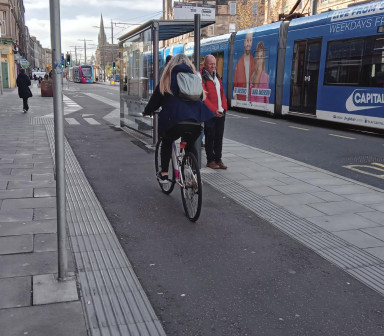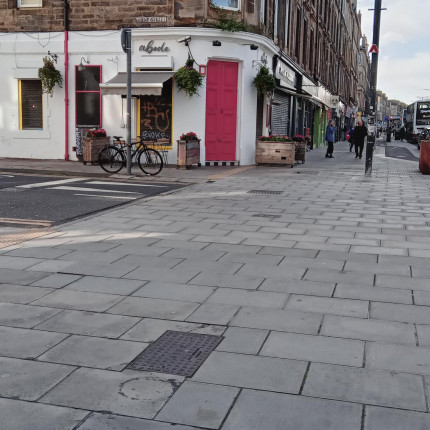This post highlights an important piece of research commissioned by Guide Dogs, with the full report and recommendations available here: Streets Ahead Campaign | Guide Dogs. The research was commissioned in response to concerns raised by blind and partially sighted people about certain aspects of pavement and road infrastructure.
Carried out by University College London, the study focused on bus stops and footways designed to accommodate cycle lanes, as well as the challenges posed by continuous footways. The findings revealed a strong fear response from blind and partially sighted individuals to these designs, emphasising the urgent need for local authorities to reconsider these features.
Working with service users, particularly in the Leith area of Edinburgh, has made the difficulties of these designs clear. Leith Walk features both floating island bus stops and continuous footways. Floating island bus stops (see picture) pose the challenge of knowing when a cyclist is approaching, as visually impaired individuals must cross the cycleway to reach the bus stop. With cyclists often travelling at moderate to fast speeds, this makes crossing extremely stressful.

"These designs create constant anxiety, and some may feel they can no longer access certain areas safely, which has a serious impact on their independence."
Continuous footways (see picture), where the pavement remains level across the crossing of a minor road, are meant to give pedestrians priority, relying on eye contact between pedestrians and drivers. This creates two major issues: visually impaired people may struggle to recognise they’ve entered the road, and they cannot rely on eye contact to know when it is safe to cross.
One visually impaired resident from Leith described the designs on Leith Walk as “a nightmare… as well as the usual alerts to people around me there are cyclists who I feel are just terrorising me as they don’t slow down even at the designated crossing points.”
Our service users depend on walking local routes and accessing public transport. These designs create constant anxiety, and some may feel they can no longer access certain areas safely, which has a serious impact on their independence.
Unfortunately, these are just two examples of infrastructure creating hazards for our service users. We hope that Guide Dogs’ comprehensive research prompts action from local authorities to bring about much-needed improvements soon.

You may also be interested in
Judith Takes Boccia To Birmingham
Judith Crawford, Sporting and Partnerships Worker at Sight Scotland Veterans, had the exciting opportunity last week to share her expertise with a variety of organisations from across the UK by leading Boccia workshops at the 2024 Visionary Conferenc
First Blind Yoga Classes Launched by Sight Scotland
Sight Scotland is proud to announce the launch of its first-ever yoga classes specifically designed for people living with vision impairment.
Sight Scotland and Sight Scotland Veterans write to NHS Lothian for answers on the 6-month emergency closure of the Edinburgh eye Pavilion
The Princess Alexandra Eye Pavilion in Edinburgh, an essential provider of eye health care for NHS Lothian patients, will be closed for 6 months from the end of October to undergo urgent plumbing repairs.
Mobility Matters blog: pedestrian accessibility across the city of Edinburgh
Caroline Hedley, one of seven Rehabilitation & Mobility Workers covering Edinburgh, East Lothian & Midlothian for Sight Scotland, talks about pedestrian accessibility across the city of Edinburgh in her latest Mobility Matters blog.